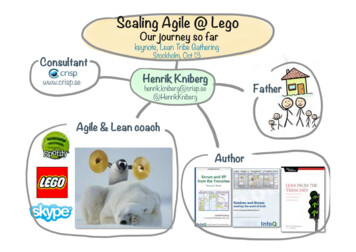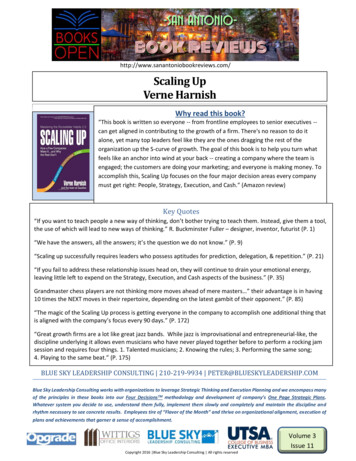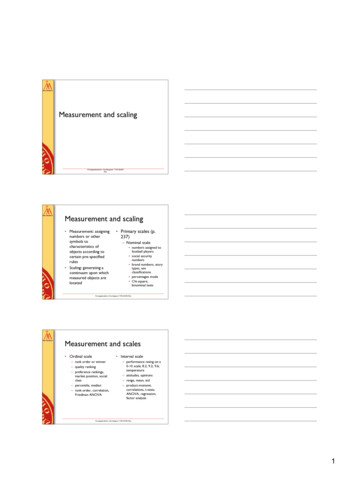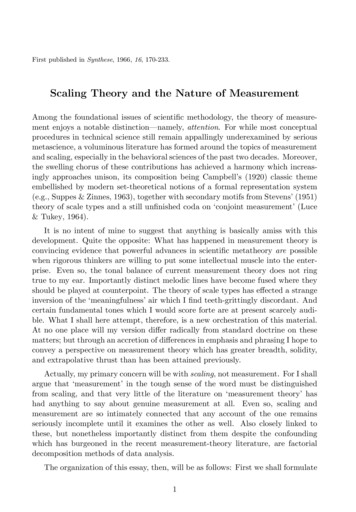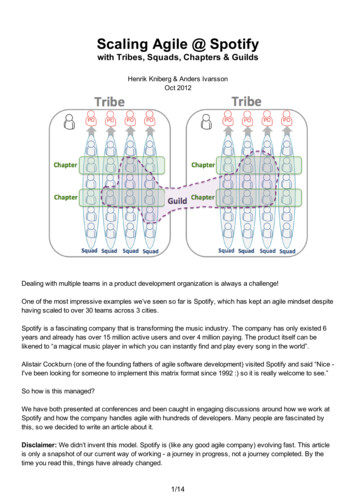
Transcription
Scaling Agile @ Spotifywith Tribes, Squads, Chapters & GuildsHenrik Kniberg & Anders IvarssonOct 2012Dealing with multiple teams in a product development organization is always a challenge!One of the most impressive examples we’ve seen so far is Spotify, which has kept an agile mindset despitehaving scaled to over 30 teams across 3 cities.Spotify is a fascinating company that is transforming the music industry. The company has only existed 6years and already has over 15 million active users and over 4 million paying. The product itself can belikened to “a magical music player in which you can instantly find and play every song in the world”.Alistair Cockburn (one of the founding fathers of agile software development) visited Spotify and said “Nice - I've been looking for someone to implement this matrix format since 1992 :) so it is really welcome to see.”So how is this managed?We have both presented at conferences and been caught in engaging discussions around how we work atSpotify and how the company handles agile with hundreds of developers. Many people are fascinated bythis, so we decided to write an article about it.Disclaimer: We didn’t invent this model. Spotify is (like any good agile company) evolving fast. This articleis only a snapshot of our current way of working - a journey in progress, not a journey completed. By thetime you read this, things have already changed.1/14
SquadsThe basic unit of development at Spotify is the Squad.A Squad is similar to a Scrum team, and is designed to feel like a mini- startup. They sit together, and theyhave all the skills and tools needed to design, develop, test, and release to production. They are aself- organizing team and decide their own way of working – some use Scrum sprints, some use Kanban,some use a mix of these approaches.Each squad has a long- term mission such as building and improving the Android client, creating the Spotifyradio experience, scaling the backend systems, or providing payment solutions. The picture belowillustrates how different squads take responsibility for different parts of the user experience.Squads are encouraged to apply Lean Startup principles such as MVP (minimum viable product) andvalidated learning. MVP means releasing early and often, and validated learning means using metrics andA/B testing to find out what really works and what doesn’t. This is summarized in the slogan “Think it, buildit, ship it, tweak it”.2/14
Because each squad sticks with one mission and one part of the product for a long time, they can reallybecome experts in that area - for example what it means to build an awesome radio experience.Most squads have an awesome workspace including a desk area, a lounge area, and a personal "huddle"room. Almost all walls are whiteboards. We've never seen a better collaboration space!yes, that's a shark flying around. perfectly normal.To promote learning and innovation, each squad is encouraged to spend roughly 10% of their time on “hackdays”. During hack days people do whatever they want, typically trying out new ideas and sharing with theirbuddies. Some teams do 1 hack day every second week, others save up for a whole “hack week”. Hackdays are not only fun, they are also a great way to stay up- to- date with new tools and techniques andsometimes lead to important product innovations!A squad doesn’t have a formally appointed squad leader, but it does have a product owner. The product3/14
owner is responsible for prioritizing the work to be done by the team, but is not involved with how they dotheir work. The product owners of different squads collaborate with each other to maintain a high- levelroadmap document that shows where Spotify as a whole is heading, and each product owner is responsiblefor maintaining a matching product backlog for their squad.A squad also has access to an agile coach, who helps them evolve and improve their way of working. Thecoaches run retrospectives, sprint planning meetings, do 1- on- 1 coaching, etc.Ideally each squad is fully autonomous with direct contact with their stakeholders, and no blockingdependencies to other squads. Basically a mini- startup. With over 30 teams, that is a challenge! We havecome a long way, but there are still plenty of improvements to be made.To aid in this, we run a quarterly survey with each squad. This helps focus our improvement efforts and findout what kind of organizational support is needed. Here’s a visual summary of one such survey, showing 5squads within a tribe:The circles show the current state, arrows show the trend. For example we can see a pattern where threesquads reports problems around releasing and that it does not seem to improve - this area needs urgentfocus! We also see that squad 4 does not have a great situation with agile coach support, but that it isalready improving. Product owner - The squad has a dedicated product owner that prioritizes the work and takes bothbusiness value and tech aspects into consideration. Agile coach - The squad has an agile coach that helps them identify impediments and coachesthem to continuously improve their process. Influencing work - Each squad member can influence his/her work, be an active part in planningand choose which tasks to work on. Every squad member can spend 10% of his/her time on hackdays. Easy to release - The squad can (and does!) get stuff live with minimal hassle and sync. Process that fits the team - The squad feels ownership of their process and continuously improvesit. Mission - The squad has a mission that everyone knows and cares about, and stories on thebacklog are related to the mission. Organizational support - The squad knows where to turn to for problem solving support, fortechnical issues as well as “soft” issues.4/14
TribesA tribe is a collection of squads that work in related areas – such as the music player, or backendinfrastructure.The tribe can be seen as the “incubator” for the squad mini- startups. , and have a fair degree of freedom andautonomy. Each tribe has a tribe lead who is responsible for providing the best possible habitat for thesquads within that tribe. The squads in a tribe are all physically in the same office, normally right next toeach other, and the lounge areas nearby promote collaboration between the squads.Tribes are sized based on the concept of the “Dunbar number”, which says that most people cannotmaintain a social relationship with more than 100 people or so (the number is actually larger for groups thatare under intense survival pressure, which isn’t really the case at Spotify, believe it or not.). When groupsget too big, we start seeing more things like restrictive rules, bureaucracy, politics, extra layers ofmanagement, and other waste.So tribes are designed to be smaller than 100 people or so.5/14
Tribes hold gatherings on a regular basis, an informal get- together where they show the rest of the tribe (orwhoever shows up) what they are working on, what they have delivered and what others can learn fromwhat they are currently doing. This includes live demos of working software, new tools and techniques, coolhack- day projects, etc.Squad dependenciesWith multiple squads there will always be dependencies. Dependencies are not necessarily bad - squadssometimes need to work together to build something truly awesome. Nevertheless, our goal is to havesquads be as autonomous as possible, especially minimizing dependencies that are blocking or slowing asquad down.To aid in this, we regularly ask all our squads which other squads they depend on, and to what extent thosedependencies are blocking or slowing the squad down. Here’s an example:TextWe then discuss ways to eliminate the problematic dependencies, especially blocking and cross- tribedependencies. This often leads to reprioritization, reorganization, architectural changes or technicalsolutions.6/14
The survey also helps us see patterns around how squads depend on each other - for example that moreand more squads seems to be slowed down by operations. We use a simple graph to track how the varioustypes of dependencies increase or decrease over time.Scrum has a practice called “scrum of scrums”, a synchronization meeting where one person from eachteam meets to discuss dependencies. We don’t usually do scrum of scrums at Spotify, mainly becausemost of the squads are fairly independent and don’t need such a coordination meeting.Instead, scrum of scrums happens “on demand”. For example we recently had a large project that requiredthe coordinated work of multiple squads for a few months.To make this work, the teams had a daily sync meeting where they identified and resolved dependenciesbetween the squads, and used a board with sticky notes to keep track of unresolved dependencies.7/14
A common source of dependency issues at many companies is development vs operations. Mostcompanies we’ve worked with have some kind of a handoff from dev to ops, with associated friction anddelays.At Spotify there is a separate operations team, but their job is not to make releases for the squads - theirjob is to give the squads the support they need to release code themselves;; support in the form ofinfrastructure, scripts, and routines. They are, in a sense, “building the road to production”.It’s an informal but effective collaboration, based on face- to- face communication rather than detailedprocess documentation.8/14
Chapters and guildsThere is a downside to everything, and the potential downside to full autonomy is a loss of economies ofscale. The tester in squad A may be wrestling with a problem that the tester in squad B solved last week. Ifall testers could get together, across squads and tribes, they could share knowledge and create tools forthe benefit of all squads.If each squad was fully autonomous and had no communication with other squads, then what is the point ofhaving a company? Spotify might as well be chopped into 30 different small companies.That’s why we have Chapters and Guilds. This is the glue that keeps the company together, it gives ussome economies of scale without sacrificing too much autonomy.The chapter is your small family of people having similar skills and working within the same generalcompetency area, within the same tribe.Each chapter meets regularly to discuss their area of expertise and their specific challenges - for examplethe testing chapter, the web developer chapter or the backend chapter.The chapter lead is line manager for his chapter members, with all the traditional responsibilities such asdeveloping people, setting salaries, etc. However, the chapter lead is also part of a squad and is involved inthe day- to- day work, which helps him stay in touch with reality.Now, reality is always messier than pretty pictures like the one above. For example, chapter members arenot evenly distributed across the squads;; some squads have lots of web developers, some have none. Butthe picture should give you the general idea.9/14
A Guild is a more organic and wide- reaching “community of interest”, a group of people that want to shareknowledge, tools, code, and practices. Chapters are always local to a Tribe, while a guild usually cutsacross the whole organization. Some examples are: the web technology guild, the tester guild, the agilecoach guild, etc.A guild often includes all the chapters working in that area and their members, for example the testing guildincludes all the testers in all testing chapters, but anybody who is interested can join any guild.Each guild has a “guild coordinator” who, well, does just that :o)As an example of guild work, we recently had a “Web Guild Unconference”, an open space event where allweb developers at Spotify gathered up in Stockholm to discuss challenges and solutions within their field.10/14
Another example is the agile coach guild. The coaches are spread all over the organization, but shareknowledge continuously and meet regularly to collaborate on the high level organizational improvementareas, which we track on an improvement board.Wait a sec,
Scaling Agile @ Spotify with Tribes, Squads, Chapters & Guilds Henrik Kniberg & Anders Ivarsson Oct 2012 Dealing with multiple teams in a product development organization is always a challenge! One of the most impressive examples we’ve seen so far is Spotify, which has kept an agile mindset despite having scaled to over 30 teams across 3 cities. Spotify is a fascinating company that is .

